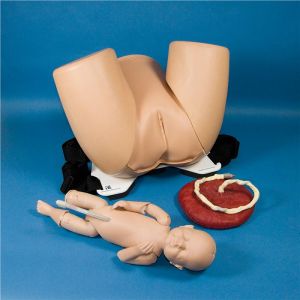
Problem being addressed
Obstructed labor is a leading cause of maternal and infant mortality and morbidity throughout the world. The most common causes of obstructed labor are cephalopelvic disproportion (64.9%) and malpresentations (26.2%). Those who are shorter than 150 cm or younger than 18 are twice as likely to experience obstructed labor. Having staff trained in techniques to deal with various types of obstructed labor is critical to improving mortality and morbidity rates.
Fetal shoulder dystocia is a common form of obstructed labor. In the U.S., 40% of the malpractice lawsuits related to birth involve cases of injury that arise from shoulder dystocia.
Detailed description of the solution
The PROMPT Birthing Simulator is an anatomical representation of birth and is used in training nurses, midwives, and physicians for standard and special obstetric procedures. The product was originally designed to improve training in maneuvers pertaining to the management of shoulder dystocia. The model is available with or without strain gauge feedback.
Training involving the PROPMT Birthing Simulator covers risk factors, recognition, demonstration of resolution maneuvers, documentation of shoulder dystocia, as well as a simulated shoulder dystocia scenario. Comprehensive training aims to simplify the management of shoulder dystocia using a stepwise approach of calling for help and implementing the McRoberts’ position, suprapubic pressure, and internal maneuvers.
Designed by
- Designed by:Limbs and Things Ltd, Bristol, U.K.
When and where it was tested/implemented
United Kingdom.
Funding Source
References
Peer-reviewed publication
Crofts, J. F. A., Georgios; Read, Mike; Sibanda, Thabani; Draycott, Timothy J. (2005). Shoulder dystocia training using a new birth training mannequin. BJOG: An International Journal of Obstetrics & Gynaecology, 112(7), 997-999.
Draycott, T. J., J. F. Crofts, et al. (2008). Improving Neonatal Outcome Through Practical Shoulder Dystocia Training. Obstet Gynecol, 112(1), 14-20.
Crofts J, Winter C, Sowter M. (2011). Practical simulation training for maternity care—where we are and where next. BJOG, 118(Suppl. 3), 11–16.